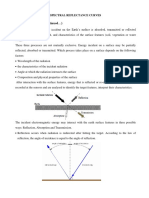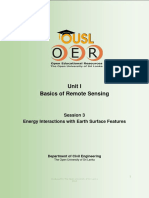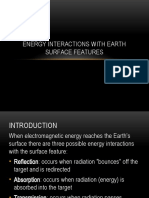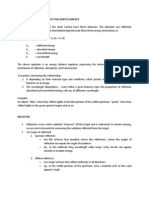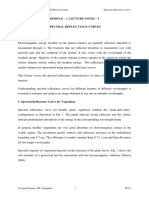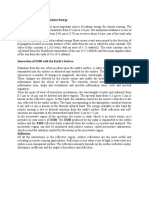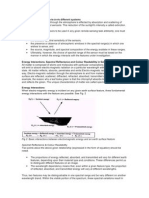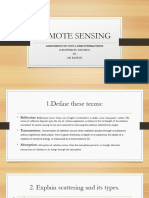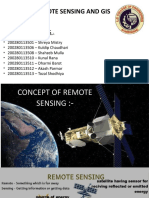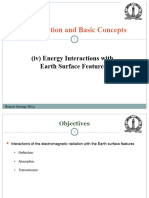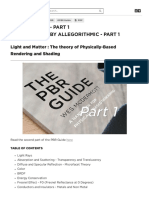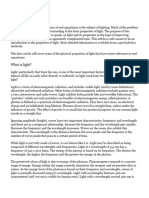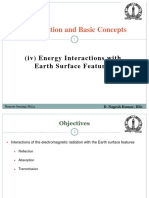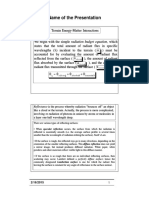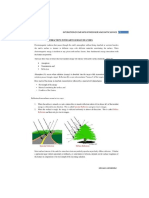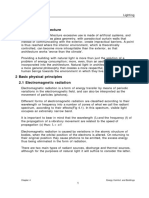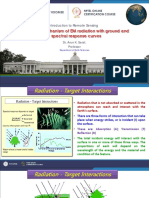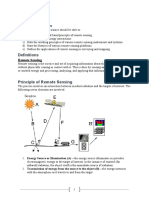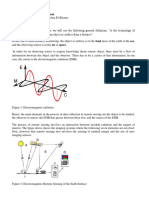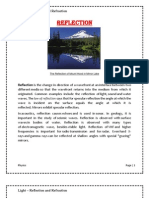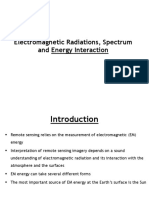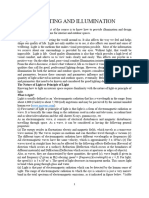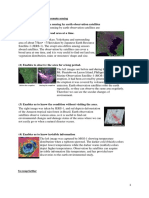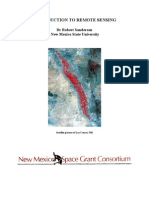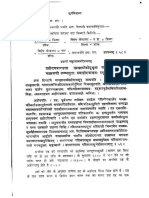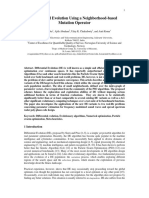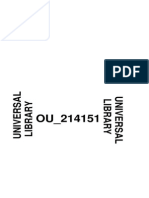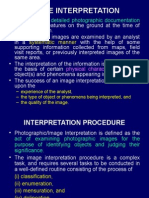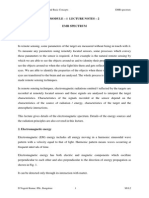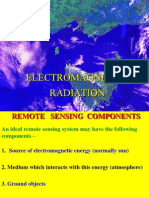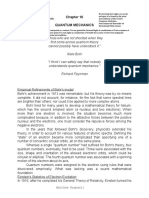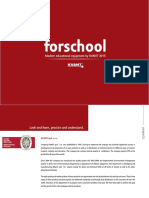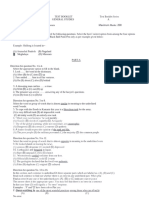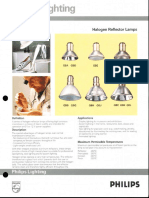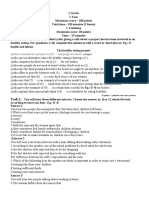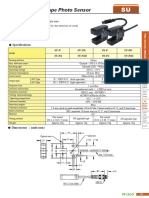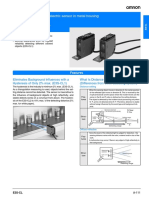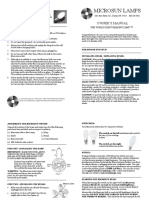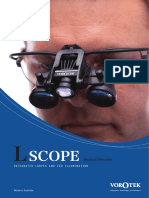Lecture 4
Lecture 4
Uploaded by
Yogesh SharmaCopyright:
Available Formats
Lecture 4
Lecture 4
Uploaded by
Yogesh SharmaOriginal Description:
Copyright
Available Formats
Share this document
Did you find this document useful?
Is this content inappropriate?
Copyright:
Available Formats
Lecture 4
Lecture 4
Uploaded by
Yogesh SharmaCopyright:
Available Formats
Remote Sensing: Introduction and Basic Concepts
Energy interactions with earth surface features
MODULE 1 LECTURE NOTES 4
ENERGY INTERACTIONS WITH EARTH SURFACE FEATURES
Energy incident on the Earths surface is absorbed, transmitted or reflected depending on the
wavelength and characteristics of the surface features (such as barren soil, vegetation, water
body). Interaction of the electromagnetic radiation with the surface features is dependent on
the characteristics of the incident radiation and the feature characteristics. After interaction
with the surface features, energy that is reflected or re-emitted from the features is recorded at
the sensors and are analysed to identify the target features, interpret the distance of the object,
and /or its characteristics.
This lecture explains the interaction of the electromagnetic energy with the Earths surface
features.
2. Energy Interactions
The incident electromagnetic energy may interact with the earth surface features in three
possible ways: Reflection, Absorption and Transmission. These three interactions are
illustrated in Fig. 1.
Incident radiation
Reflection
Earth
Transmission
Absorption
Fig. 1. Energy interactions with earth surface features
Reflection occurs when radiation is redirected after hitting the target. According to the law of
reflection, the angle of incidence is equal to the angle of reflection (Fig. 2) .
D Nagesh Kumar, IISc, Bangalore
M1L4
Remote Sensing: Introduction and Basic Concepts
Energy interactions with earth surface features
Fig. 2 Energy reflection
Absorption occurs when radiation is absorbed by the target. The portion of the EM energy
which is absorbed by the Earths surface is available for emission and as thermal radiation at
longer wavelengths (Fig. 3).
Fig. 3 Energy absorption and emission
Transmission occurs when radiation is allowed to pass through the target. Depending upon
the characteristics of the medium, during the transmission velocity and wavelength of the
radiation changes, whereas the frequency remains same. The transmitted energy may further
get scattered and / or absorbed in the medium.
These three processes are not mutually exclusive. Energy incident on a surface may be
partially reflected, absorbed or transmitted. Which process takes place on a surface depends
on the following factors:
Wavelength of the radiation
Angle at which the radiation intersects the surface
Composition and physical properties of the surface
D Nagesh Kumar, IISc, Bangalore
M1L4
Remote Sensing: Introduction and Basic Concepts
Energy interactions with earth surface features
The relationship between reflection, absorption and transmission can be expressed through
the principle of conservation of energy. Let EI denotes the incident energy, ER denotes the
reflected energy, EA denotes the absorbed energy and ET denotes the transmitted energy. Then
the principle of conservation of energy (as a function of wavelength ) can be expressed as
EI () = ER () + EA() + ET ()
(1)
Since most remote sensing systems use reflected energy, the energy balance relationship can
be better expressed in the form
ER () = EI () - EA() - ET ()
(2)
The reflected energy is equal to the total energy incident on any given feature reduced by the
energy absorbed or transmitted by that feature.
3. Reflection
Reflection is the process in which the incident energy is redirected in such a way that the
angle of incidence is equal to the angle of reflection. The reflected radiation leaves the
surface at the same angle as it approached.
Scattering is a special type of reflection wherein the incident energy is diffused in many
directions and is sometimes called diffuse reflection.
Fig.4 Reflection and scattering
When electromagnetic energy is incident on the surface, it may get reflected or scattered
depending upon the roughness of the surface relative to the wavelength of the incident
energy. If the roughness of the surface is less than the wavelength of the radiation or the ratio
of roughness to wavelength is less than 1, the radiation is reflected. When the ratio is more
than 1 or if the roughness is more than the wavelength, the radiation is scattered.
Fraction of energy that is reflected / scattered is unique for each material. This will aid in
distinguishing different features on an image.
D Nagesh Kumar, IISc, Bangalore
M1L4
Remote Sensing: Introduction and Basic Concepts
Energy interactions with earth surface features
A feature class denotes distinguishing primitive characteristic or attribute of an image that
have been classified to represent a particular land cover type/spectral signature. Within one
feature class, the proportion of energy reflected, emitted or absorbed depends on the
wavelength. Hence, in spectral range two features may be indistinguishable; but their
reflectance properties may be different in another spectral band. In multi-spectral remote
sensing, multiple sensors are used to record the reflectance from the surface features at
different wavelength bands and hence to differentiate the target features.
Variations in the spectral reflectance within the visible spectrum give the colour effect to the
features. For example, blue colour is the result of more reflection of blue light. An object
appears as green when it reflects highly in the green portion of the visible spectrum. Leaves
appear green since its chlorophyll pigment absorbs radiation in the red and blue wavelengths
but reflects green wavelengths. Similarly, water looks blue-green or blue or green if viewed
through visible band because it reflects the shorter wavelengths and absorbs the longer
wavelengths in the visible band. Water also absorbs the near infrared wavelengths and hence
appears darker when viewed through red or near infrared wavelengths. Human eye uses
reflected energy variations in the visible spectrum to discriminate between various features.
For example, Fig.5 shows a part of the Krishna River Basin as seen in different bands of the
Landsat ETM+ imagery. As the concepts of false color composite (FCC) have been covered
in module 4, readers are advised to refer to the material in module 4 for better understanding
of the color composite imageries as shown in Fig. 5. Reflectance of surface features such as
water, vegetation and fallow lands are different in different wavelength bands. A combination
of more than one spectral band helps to attain better differentiation of these features.
D Nagesh Kumar, IISc, Bangalore
M1L4
Remote Sensing: Introduction and Basic Concepts
Energy interactions with earth surface features
Fig. 5 A part of the Krishna River Basin as seen in different bands of the Landsat ETM+
images
3. Diffuse and Specular Reflection
Energy reflection from a surface depends on the wavelength of the radiation, angle of
incidence and the composition and physical properties of the surface.
Roughness of the target surface controls how the energy is reflected by the surface. Based on
the roughness of the surface, reflection occurs in mainly two ways.
i. Specular reflection: It occurs when the surface is smooth and flat. A mirror-like or
smooth reflection is obtained where complete or nearly complete incident energy is
reflected in one direction. The angle of reflection is equal to the angle of incidence.
Reflection from the surface is the maximum along the angle of reflection, whereas in any
other direction it is negligible.
ii. Diffuse (Lambertian) reflection: It occurs when the surface is rough. The energy is
reflected uniformly in all directions. Since all the wavelengths are reflected uniformly in
all directions, diffuse reflection contains spectral information on the "colour" of the
reflecting surface. Hence, in remote sensing diffuse reflectance properties of terrain
features are measured. Since the reflection is uniform in all direction, sensors located at
any direction record the same reflectance and hence it is easy to differentiate the features.
D Nagesh Kumar, IISc, Bangalore
M1L4
Remote Sensing: Introduction and Basic Concepts
Energy interactions with earth surface features
Based on the nature of reflection, surface features can be classified as Specular reflectors,
Lambertian reflectors (Fig. 6).
An ideal specular reflector completely reflects the incident energy with angle of reflection
equal to the angle incidence.
An ideal Lambertian or diffuse reflector scatters all the incident energy equally in all the
directions.
The specular or diffusive characteristic of any surface is determined by the roughness of the
surface in comparison to the wavelength of the incoming radiation. If the wavelengths of the
incident energy are much smaller than the surface variations or the particle sizes, diffuse
reflection will dominate. For example, in the relatively long wavelength radio range, rocky
terrain may appear smooth to incident energy. In the visible portion of the spectrum, even a
material such as fine sand appears rough while it appears fairly smooth to long wavelength
microwaves.
Most surface features of the earth are neither perfectly specular nor perfectly diffuse
reflectors. In near specular reflection, though the reflection is the maximum along the angle
of reflection, a fraction of the energy also gets reflected in some other angles as well. In near
Lambertian reflector, the reflection is not perfectly uniform in all the directions.
The
characteristics of different types of reflectors are shown in Fig. 6.
D Nagesh Kumar, IISc, Bangalore
M1L4
Remote Sensing: Introduction and Basic Concepts
Energy interactions with earth surface features
Angle of incidence
Angle of reflection
Ideal specular
Ideal diffusive
Near specular
Near diffusive
Fig. 6. Different types of reflectors
Lambertian reflectors are considered ideal for remote sensing. The reflection from an ideal
Lambertian surface will be the same irrespective of the location of the sensor. On the other
hand, in case of an ideal specular reflector, maximum brightness will be obtained only at one
location and for the other locations dark tones will be obtained from the same target. This
variation in the spectral signature for the same feature affects the interpretation of the remote
sensing data.
Most natural surfaces observed using remote sensing are approximately Lambertian at visible
and IR wavelengths. However, water provides specular reflection. Water generally gives a
dark tone in the image. However due to the specular reflection, it gives a pale tone when the
sensor is located in the direction of the reflected energy.
4. Spectral Reflectance Curves
The reflectance characteristics of earth surface features are expressed as the ratio of energy
reflected by the surface to the energy incident on the surface. This is measured as a function
of wavelength and is called spectral reflectance, R. It is also known as albedo of the surface.
Spectral reflectance or albedo can be mathematically defined as
D Nagesh Kumar, IISc, Bangalore
M1L4
Remote Sensing: Introduction and Basic Concepts
Energy interactions with earth surface features
ER
EI
Energy of wavelength reflected from the object
100
Energy of wavelength incident on the object
(3)
Albedo of various Earth surface features are given in Table 1.
Table 1. Albedo of various Earth surface features (From Gibson, 2000)
Surface type
Albedo %
Grass
25
Concrete
20
Water
5-70
Fresh snow
80
Forest
5-10
Thick cloud
75
Dark soil
5-10
Albedo of fresh snow is generally very high. Dry snow reflects almost 80% of the energy
incident on it. Clouds also reflect a majority of the incident energy. Dark soil and concrete
generally show very low albedo. Albedo of vegetation is also generally low, but varies with
the canopy density. Albedo of forest areas with good canopy cover is as low as 5-10%.
Albedo of water ranges from 5 to 70 percentage, due to the specular reflection characteristics.
Albedo is low at lower incidence angle and increases for higher incidence angles.
The energy that is reflected by features on the earth's surface over a variety of different
wavelengths will give their spectral responses. The graphical representation of the spectral
response of an object over different wavelengths of the electromagnetic spectrum is termed as
spectral reflectance curve. These curves give an insight into the spectral characteristics of
different objects, hence used in the selection of a particular wavelength band for remote
sensing data acquisition.
For example, Fig. 7 shows the generalized spectral reflectance curves for deciduous (broadleaved) and coniferous (needle-bearing) trees. Spectral reflectances varies within a given
D Nagesh Kumar, IISc, Bangalore
M1L4
Remote Sensing: Introduction and Basic Concepts
Energy interactions with earth surface features
material i.e., spectral reflectance of one decisuous tree will not be identical with another.
Hence the generalized curves are shown as a ribbon and not as a single line. These curves
help in the selection of proper sensor system in order to differentiate deciduous and
coniferous trees.
Fig. 7. Spectral reflectance curves for deciduous and coniferous trees (Lillesand et al., 2004)
As seen from Fig. 7, spectral reflectance curves for each tree type are overlapping in most of
the visible portion. A choice of visible spectrum is not a feasible option for differentiation
since both the deciduous and coniferous trees will essentially be seen in shades of green.
However, in the near infra red (NIR) they are quite different and distinguishable. Within the
electromagnetic spectrum, the NIR represents a wavelength range from (0.7-1) to 5 microns.
A comparison of photographs taken in visible band and NIR band is shown in Fig. 8. It
should be noted that panchromatic refers to black and white imagery that is exposed by all
visible light. In visible band, the tone is same for both trees. However, on infrared
photographs, deciduous trees show a much lighter tone due to its higher infrared reflectance
than conifers.
D Nagesh Kumar, IISc, Bangalore
M1L4
Remote Sensing: Introduction and Basic Concepts
Energy interactions with earth surface features
(a)
(b)
Fig. 8. (a) Panchromatic photograph using reflected sunlight over the visible wavelength band
0.4 to 0.7 mm and (b) Black and white infrared photograph using reflected sunlight over 0.7
to 0.9 mm wavelength band (Lillesand et al., 2004)
In remote sensing, the spectral reflectance characteristics of the surface features have been
used to identify the surface features and to study their characteristics. This requires basic
understanding of the general reflectance characteristics of different feature, which is covered
in the next lecture.
D Nagesh Kumar, IISc, Bangalore
10
M1L4
Remote Sensing: Introduction and Basic Concepts
Energy interactions with earth surface features
Bibliography
1. Lillesand, T. M, Kiefer, R. W., Chipman, J. W., [2004]. Remote Sensing and Image
Interpretation, John Wiley & Sons, New York, pp. 321-332.
D Nagesh Kumar, IISc, Bangalore
11
M1L4
You might also like
- 4.radiation - Target InteractionsDocument28 pages4.radiation - Target InteractionsSujata SarkarNo ratings yet
- Energy Interactions (Continued ) : Spectral Reflectance CurvesDocument12 pagesEnergy Interactions (Continued ) : Spectral Reflectance CurvesAnish PokharelNo ratings yet
- Session 3Document22 pagesSession 3leeNo ratings yet
- Energy Interactions With Earth Surface FeaturesDocument10 pagesEnergy Interactions With Earth Surface FeaturesBernalyn ManaogNo ratings yet
- Energy Interactions With The Earth SurfaceDocument3 pagesEnergy Interactions With The Earth SurfaceAmirulTarliNo ratings yet
- RS&GIS Unit1Document15 pagesRS&GIS Unit1kusumelekhazNo ratings yet
- Spectral Reflect AnceDocument16 pagesSpectral Reflect AnceAnubhav SrivastavaNo ratings yet
- Interaction With Earth Surface (Remote Sensing)Document33 pagesInteraction With Earth Surface (Remote Sensing)Sadia Sheikh100% (1)
- Module - 1 Lecture Notes - 5: Remote Sensing: Introduction and Basic Concepts Spectral Reflectance CurvesDocument13 pagesModule - 1 Lecture Notes - 5: Remote Sensing: Introduction and Basic Concepts Spectral Reflectance CurvesYogesh SharmaNo ratings yet
- Remote SensingDocument6 pagesRemote SensingtsbdxndNo ratings yet
- Spectral Reflectance Curves PDFDocument13 pagesSpectral Reflectance Curves PDFSherlock mantelNo ratings yet
- Handout 03Document7 pagesHandout 03JAMESNo ratings yet
- Characteristics of Solar Radiant EnergyDocument2 pagesCharacteristics of Solar Radiant EnergyrbhavishNo ratings yet
- Spectral Characteristics VisDocument3 pagesSpectral Characteristics VissatishnekkantiNo ratings yet
- unit 3 remote sensingDocument15 pagesunit 3 remote sensingKuldeep SinghNo ratings yet
- Basics of Remote Sensing and Gis: Group MembersDocument36 pagesBasics of Remote Sensing and Gis: Group MembersKrunal RanaNo ratings yet
- RS Lecture3 Elements of RS PDFDocument54 pagesRS Lecture3 Elements of RS PDFAbhinav ThakurNo ratings yet
- M1L4 Basic - Energy Interactionswith Earth SurfaceDocument24 pagesM1L4 Basic - Energy Interactionswith Earth SurfaceBalwant SinghNo ratings yet
- Lec 07Document32 pagesLec 07Jonald CastañedaNo ratings yet
- 2_-3 Principles of Remote Sensing orbit, Electromagnetic radiation, diffraction, electro-optical-1Document14 pages2_-3 Principles of Remote Sensing orbit, Electromagnetic radiation, diffraction, electro-optical-1aman992225No ratings yet
- Chapter 5Document16 pagesChapter 5Jithu JohnsonNo ratings yet
- Spectral Reflectance Curve: - Ratio of Energy Reflected by The Surface To The Energy Incident On The SurfaceDocument38 pagesSpectral Reflectance Curve: - Ratio of Energy Reflected by The Surface To The Energy Incident On The Surfaceruchi100% (1)
- Electromagn Etic Radiations: Lecture #8Document17 pagesElectromagn Etic Radiations: Lecture #8Kibriya Hamood shahNo ratings yet
- The PBR Guide - Part 1Document17 pagesThe PBR Guide - Part 1Rafael MoreiraNo ratings yet
- Iluminacion (Texto en Ingles)Document10 pagesIluminacion (Texto en Ingles)jonathan lopezNo ratings yet
- Radiation Heat TransferDocument22 pagesRadiation Heat TransferPratiksha GoreNo ratings yet
- Wireless Communications Systems (DCS Unit-4)Document18 pagesWireless Communications Systems (DCS Unit-4)Mukesh100% (2)
- Energy Interactions With Earth Surface Features RemoteDocument24 pagesEnergy Interactions With Earth Surface Features RemoteZoro D. GhoulNo ratings yet
- Remote SensingDocument24 pagesRemote Sensingsom ranaNo ratings yet
- Interaction of Emr With Atmosphere and Earth Surface 5 638Document3 pagesInteraction of Emr With Atmosphere and Earth Surface 5 638Ramendra TiwariNo ratings yet
- 1.1 Light in Architecture: Energy Comfort and BuildingsDocument27 pages1.1 Light in Architecture: Energy Comfort and BuildingsParvathy ShekharNo ratings yet
- Elements Remote SensingDocument21 pagesElements Remote Sensingtarameer2020No ratings yet
- Remote Sensing and GisDocument17 pagesRemote Sensing and Gismd khajaNo ratings yet
- Interactions With The AtmosphereDocument3 pagesInteractions With The Atmosphererbhavish0% (1)
- G10 SCIENCE 2nd QRT - SUMMATIVE TEST 2021 2022Document5 pagesG10 SCIENCE 2nd QRT - SUMMATIVE TEST 2021 2022Kyle OrlanesNo ratings yet
- Week-2 Module-1 Interaction Mechanism of EM Radiation With Ground and Spectral Response CurvesDocument15 pagesWeek-2 Module-1 Interaction Mechanism of EM Radiation With Ground and Spectral Response CurvesAKASH MAURYANo ratings yet
- Gen Physics 2 Q4M2Document30 pagesGen Physics 2 Q4M2Virly MelladoNo ratings yet
- Solar Radiation of The High Alps: Mario BlumthalerDocument11 pagesSolar Radiation of The High Alps: Mario BlumthalerDale Francis ClapanoNo ratings yet
- Remote SensingDocument48 pagesRemote SensingSimion MoraraNo ratings yet
- GISpptDocument121 pagesGISpptgiyis43628No ratings yet
- Week-1 Module-5 Interaction Mechanism of EM Radiation With Ground and Spectral Response CurvesDocument15 pagesWeek-1 Module-5 Interaction Mechanism of EM Radiation With Ground and Spectral Response CurvesTrambak BhattacharyaNo ratings yet
- Remote Sensing and PlatformDocument13 pagesRemote Sensing and Platformmd khajaNo ratings yet
- Module - 1 Lecture Notes - 3: Remote Sensing: Introduction and Basic Concepts Energy Interactions in The AtmosphereDocument10 pagesModule - 1 Lecture Notes - 3: Remote Sensing: Introduction and Basic Concepts Energy Interactions in The AtmosphereYogesh SharmaNo ratings yet
- UNIT-1 Solar Energy Radiation L-2Document28 pagesUNIT-1 Solar Energy Radiation L-2guptaraj07rgNo ratings yet
- Remote Sensing Studies Notes - ShortDocument18 pagesRemote Sensing Studies Notes - ShortRaj GuptaNo ratings yet
- Physics Radiant Energy Light: GE 143 Remote SensingDocument1 pagePhysics Radiant Energy Light: GE 143 Remote SensingPISALBO, JEXTER P.No ratings yet
- Fundamental of LightDocument25 pagesFundamental of Lightjeanneth lontocNo ratings yet
- ReflectionDocument24 pagesReflectionjainamanjainjainNo ratings yet
- Electromagnetic Radiations, Spectrum and Energy InteractionDocument32 pagesElectromagnetic Radiations, Spectrum and Energy InteractionRafia AbidNo ratings yet
- Remote Sensing and Gis Unit - Iii Rs-IiDocument12 pagesRemote Sensing and Gis Unit - Iii Rs-Iivijjikewlguy7116No ratings yet
- Antennas and PropagationDocument122 pagesAntennas and PropagationThatsanaphon ThungkhanaiNo ratings yet
- LIGHTING AND ILLUMINATION-UNILAG - Docx111 - 114719Document54 pagesLIGHTING AND ILLUMINATION-UNILAG - Docx111 - 114719pucekandulsNo ratings yet
- Remote Sensing 2017 Q and A-22Document16 pagesRemote Sensing 2017 Q and A-22MTE HODNo ratings yet
- Ebook Rs Introduction SandersonDocument38 pagesEbook Rs Introduction SandersonBeni RaharjoNo ratings yet
- Uv VisablespectroscopyatheerDocument18 pagesUv VisablespectroscopyatheermanishaNo ratings yet
- Maxwell's Equations and the Principles of Electromagnetic PhenomenaFrom EverandMaxwell's Equations and the Principles of Electromagnetic PhenomenaNo ratings yet
- Intensity of Electromagnetic Waves as a Function of Frequency, Source Distance and Aperture AngleFrom EverandIntensity of Electromagnetic Waves as a Function of Frequency, Source Distance and Aperture AngleNo ratings yet
- Ophthalmic Dispensing Revision Guide: First Year Part OneFrom EverandOphthalmic Dispensing Revision Guide: First Year Part OneRating: 4 out of 5 stars4/5 (3)
- Suryank 2Document150 pagesSuryank 2Yogesh SharmaNo ratings yet
- 002 Surya Siddhant Hindi PDFDocument100 pages002 Surya Siddhant Hindi PDFYogesh Sharma88% (8)
- Hybrid Differential Evolution and Enhanced Particle Swarm Optimisation Technique For Design of Reconfigurable Phased Antenna ArraysDocument8 pagesHybrid Differential Evolution and Enhanced Particle Swarm Optimisation Technique For Design of Reconfigurable Phased Antenna ArraysYogesh SharmaNo ratings yet
- Differential Evolution Using A Neighborhood-Based PDFDocument28 pagesDifferential Evolution Using A Neighborhood-Based PDFYogesh SharmaNo ratings yet
- Differential Evolution Using A Neighborhood-Based Mutation OperatorDocument42 pagesDifferential Evolution Using A Neighborhood-Based Mutation OperatorYogesh SharmaNo ratings yet
- The Ramayana Vol III Third Edition PDFDocument489 pagesThe Ramayana Vol III Third Edition PDFYogesh SharmaNo ratings yet
- Opposition-Based Differential EvolutionDocument16 pagesOpposition-Based Differential EvolutionYogesh SharmaNo ratings yet
- Ce-636 4 - Image InterpretationDocument50 pagesCe-636 4 - Image InterpretationYogesh SharmaNo ratings yet
- Lecture 8Document10 pagesLecture 8Yogesh SharmaNo ratings yet
- CE-636 Soft ClassificationDocument34 pagesCE-636 Soft ClassificationYogesh SharmaNo ratings yet
- Module - 1 Lecture Notes - 3: Remote Sensing: Introduction and Basic Concepts Energy Interactions in The AtmosphereDocument10 pagesModule - 1 Lecture Notes - 3: Remote Sensing: Introduction and Basic Concepts Energy Interactions in The AtmosphereYogesh SharmaNo ratings yet
- Module - 1 Lecture Notes - 2: Remote Sensing: Introduction and Basic Concepts EMR SpectrumDocument9 pagesModule - 1 Lecture Notes - 2: Remote Sensing: Introduction and Basic Concepts EMR SpectrumYogesh SharmaNo ratings yet
- Module - 1 Lecture Notes - 5: Remote Sensing: Introduction and Basic Concepts Spectral Reflectance CurvesDocument13 pagesModule - 1 Lecture Notes - 5: Remote Sensing: Introduction and Basic Concepts Spectral Reflectance CurvesYogesh SharmaNo ratings yet
- Module - 2 Lecture Notes - 1: Remote Sensing-Remote Sensing Systems Satellites and OrbitsDocument9 pagesModule - 2 Lecture Notes - 1: Remote Sensing-Remote Sensing Systems Satellites and OrbitsYogesh SharmaNo ratings yet
- Remote Sensing 2Document64 pagesRemote Sensing 2Yogesh SharmaNo ratings yet
- Module - 2 Lecture Notes - 2: Remote Sensing-Remote Sensing Systems Spatial and Spectral ResolutionsDocument11 pagesModule - 2 Lecture Notes - 2: Remote Sensing-Remote Sensing Systems Spatial and Spectral ResolutionsYogesh SharmaNo ratings yet
- Introductory Remote Sensing: Dr. P. K. Garg Civil Engg. Deptt. Iit RoorkeeDocument78 pagesIntroductory Remote Sensing: Dr. P. K. Garg Civil Engg. Deptt. Iit RoorkeeYogesh SharmaNo ratings yet
- Remote Sensing Satellites: DR P.K. Garg Civil Engg Deptt IIT RoorkeeDocument116 pagesRemote Sensing Satellites: DR P.K. Garg Civil Engg Deptt IIT RoorkeeYogesh SharmaNo ratings yet
- Analogus CoulorDocument6 pagesAnalogus Couloryioan1821No ratings yet
- Prescolite Overview Catalog GS-15 1968Document36 pagesPrescolite Overview Catalog GS-15 1968Alan Masters100% (1)
- Granville ClassicDocument8 pagesGranville ClassicVictor VignolaNo ratings yet
- Unit 2 IlluminationDocument56 pagesUnit 2 IlluminationsiddharthaNo ratings yet
- A Further Look Behind The Lens FinalDocument30 pagesA Further Look Behind The Lens FinalLavesh Dhatavkar100% (2)
- Module-I Unit-I Oscillations and WavesDocument2 pagesModule-I Unit-I Oscillations and WavesFayaz Ahmed KhanNo ratings yet
- Color Transform Based Approach For Disease Spot Detection On Plant LeafDocument6 pagesColor Transform Based Approach For Disease Spot Detection On Plant LeafMustafa Al-hammadiNo ratings yet
- Physics For Beginners-16-Quantum MechanicsDocument9 pagesPhysics For Beginners-16-Quantum MechanicsHans Oude WeerninkNo ratings yet
- As Competition Paper 2008 Solutions: Total Mark/50Document10 pagesAs Competition Paper 2008 Solutions: Total Mark/50Ahmad HaikalNo ratings yet
- 5 Assessment and Diagnostic Procedures For Visual and Eye DisordersDocument5 pages5 Assessment and Diagnostic Procedures For Visual and Eye DisordersNica EnriquezNo ratings yet
- CatalogDocument34 pagesCatalogDiaz JubairyNo ratings yet
- Atomic Structure Short Notes 7 PageDocument7 pagesAtomic Structure Short Notes 7 PageSubhajit Gorai100% (1)
- Question Paper 2014Document56 pagesQuestion Paper 2014Sambhu RoyNo ratings yet
- Philips Halogen Reflector Lamps Bulletin 3-90Document4 pagesPhilips Halogen Reflector Lamps Bulletin 3-90Alan MastersNo ratings yet
- Parts of A LAMPDocument6 pagesParts of A LAMPKURONo ratings yet
- Chapter 12 Waves 2: NameDocument32 pagesChapter 12 Waves 2: NamesciencedocsmanNo ratings yet
- Lydia Is Involved in A Project On (0) Campaign at School.: Task 2Document7 pagesLydia Is Involved in A Project On (0) Campaign at School.: Task 2Laziz KamarovNo ratings yet
- Light Reflection and Refraction Own Notes ?Document11 pagesLight Reflection and Refraction Own Notes ?SIDDHANT BHATTNo ratings yet
- U-Shape Photo Sensor: CharacteristicDocument5 pagesU-Shape Photo Sensor: CharacteristicEdward Quispe CervantesNo ratings yet
- Obstivision: Maintenance Free Led Obstacle LightDocument6 pagesObstivision: Maintenance Free Led Obstacle LightPoelmp PakpahanNo ratings yet
- E3S-CL: Distance Setting Photoelectric Sensor in Metal HousingDocument9 pagesE3S-CL: Distance Setting Photoelectric Sensor in Metal HousingAnggi PrasetyoNo ratings yet
- PFP7 ManualDocument48 pagesPFP7 Manualzaini muhammadNo ratings yet
- Photographing Flowers With A Macro Lens: PhotzyDocument22 pagesPhotographing Flowers With A Macro Lens: PhotzyEmilNo ratings yet
- Microsun Owners Manual.20160210Document2 pagesMicrosun Owners Manual.20160210BiomedicaNo ratings yet
- Interference QuestionsDocument11 pagesInterference QuestionsKhaled SaadiNo ratings yet
- 15 Vorotek - LScope - Brochure - Web - 1219Document2 pages15 Vorotek - LScope - Brochure - Web - 1219vaitheeswaran kumaravelNo ratings yet
- Science - Light and Sound - AnswerDocument4 pagesScience - Light and Sound - Answerdonio0% (1)
- Classical Theoryof Photoelectric EffectDocument9 pagesClassical Theoryof Photoelectric EffectPascal SambreNo ratings yet
- 3dsmax Vray Rendering TutorialDocument8 pages3dsmax Vray Rendering Tutorialmaxioktavianus4368No ratings yet
- TR G2C5Document9 pagesTR G2C5Eko Sulistiyaning WarniNo ratings yet


